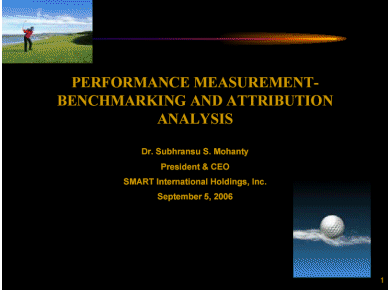 |
Performance Measurement-
Benchmarking and Attribution Analysis
Our Asset Allocation Division also guides investors in
analyzing the performance of various assets or fund managers against
appropriate benchmarks. Most often, as an industry practice, an
universe or peer group performance is treated as a benchmark
against which the performance of a fund manager is evaluated. We
believe that this is not an appropriate benchmark as ideally a
benchmark should be unambiguous, measurable, investable,
reflective of current investment opinions and specified in advance
(see CFA Institute's guidelines). Broad market indices such as the S&P 500, Russell 3000,
Wilshire 5000 etc. are not good benchmarks for most active
non-large core managers. Even style indices such as the Russell
1000 Growth, 1000 Value, 2000 Growth, or 2000 Value are not
appropriate for the vast majority of managers. Similarly, manager universes are not investable, not specified in
advance, and since they are made up of active managers they are
not the passive equivalent of an active manager. Additionally,
manager universes suffer from survivorship bias (the poor performing
managers drop out and/ or are merged with better performing
funds). Most importantly, they are usually too broadly defined to
accurately judge the skill of a specific manager. In order to
avoid these common errors, we develop
customized policy benchmarks that are truly reflective of a client's
Investment Policy Objectives and Asset Allocation
Strategy. A custom benchmark is a composite benchmark that is produced by weighting a set of asset
class indices that appropriately captures both market systematic
factors and managers' skills within a risk-return optimization
framework.
|
|
Once the custom benchmark is built, it is
easier for us to evaluate the performance of a fund manager against it
and segregate a fund manager's performance that is attributable to his idiosyncratic
skills or style such as investing in the right style, active stock-picking, sector bets, or market timing
from the general market or asset class performance. Moreover, a
manager's performance may have the end-point bias or broken clock
syndrome. When a manager’s recent performance is good, cumulative analysis
tends to make its longer term performance look good, regardless of
past performance as recent good performance hides past bad
performance. For example, Morningstar’s star ratings are based on fund’s performance
relative to a broad group of fund returns, as opposed to a more
specific benchmark that reflects the manager's true style.
|

|
|
Because of this, on February 28,
2000, at the very peak of the growth stock bubble, most of Morningstar’s five
star funds were growth funds while there were no five star value funds. Two
years later, after the value funds did well and the growth funds crashed, most
of the five star funds were value funds.
In order to avoid this, we perform
attribution analysis over various rolling-windows of say 12 months to 36 months
both on in-sample and out-of-sample basis using the Bayesian Black-Litterman
Approach. This helps us not only to segregate manager's skill or style but also
to identify his source of active alpha and consistency in achieving such active
alpha over a longer period of time.
We follow an elaborate performance
measurement process in selecting funds within each asset class or investment
style. You can have a look at the following
presentations to review our approach before we evaluate the fund managers under
the various categories: -
Equity
Value Indices Screening and Analysis July 2006;
Equity
Growth Indices Screening and Analysis July 2006;
Hedge
Fund Screening and Analysis July 2006.
Should you require further information on our asset allocation strategy or
review asset class/manager-wise performance analysis or have specific asset
allocation or product
development requirements, kindly contact us at smartam@smartinternationalholdings.org.
Related Areas: Global
Investment Strategy, Global Asset
Allocation Strategy, Product
Development- Investment Products and Managed Accounts, Wealth
Management Strategy. |
 |



